Europe · Events · Regions · Spain · Travel Miscellany · Western Europe
The Three Kings celebration in Barcelona and everything you need to know
El Día de los Reyes Magos, or the Three Kings Day is considered to be the Spanish Christmas Day, celebrated on both the night of the 5th of January and the day of the Three Kings which is the 6th of January.
 Whereas most places across the world will be winding down their Christmas spirits towards the end of December, Spain’s are still in full swing. Especially here in Barcelona, where you will continue to find exciting merry and bright markets, and admire the twinkling array of Christmas lights throughout the city.
Our blog will talk you through everything you need to know about the Day of the Three Kings in Spain, it’s history, how it’s celebrated, and key traditions involved so you can celebrate the Three Kings Day as well if you fancy.
History behind the Three Kings
The Three Kings come from the Bible, in the second chapter, verse 1-12 from the Gospel of St. Matthew, in which these ‘Magi’ followed a star all the way from the East to Bethlehem, the Kings in this sense represented the wise men. The wise men were not spoken of as Kings until the 3rd century, and they were renamed due to their wealth represented through their valuable gifts that they brought to baby Jesus; gold, frankincense and myrrh.
Whereas most places across the world will be winding down their Christmas spirits towards the end of December, Spain’s are still in full swing. Especially here in Barcelona, where you will continue to find exciting merry and bright markets, and admire the twinkling array of Christmas lights throughout the city.
Our blog will talk you through everything you need to know about the Day of the Three Kings in Spain, it’s history, how it’s celebrated, and key traditions involved so you can celebrate the Three Kings Day as well if you fancy.
History behind the Three Kings
The Three Kings come from the Bible, in the second chapter, verse 1-12 from the Gospel of St. Matthew, in which these ‘Magi’ followed a star all the way from the East to Bethlehem, the Kings in this sense represented the wise men. The wise men were not spoken of as Kings until the 3rd century, and they were renamed due to their wealth represented through their valuable gifts that they brought to baby Jesus; gold, frankincense and myrrh.
 The Three Kings Day is now celebrated on the 6th of January and is also known as the Epiphany day, it is filled with festivities. In Spain these celebrations begin on the 5th of January, with each of the Kings arriving in the towns of Spain. In Barcelona the day of the Kings is an unmissable event, thought to be one of the biggest and most beautiful in Spain.
Letters to the Three Kings
It is tradition for children to write letters to the three kings; Melchior, Caspar and Balthazar, with their wishes and their achievements. These letters can then be given to the kings in person at the parade in Barcelona, soon to be explained…
The Three Kings Day is now celebrated on the 6th of January and is also known as the Epiphany day, it is filled with festivities. In Spain these celebrations begin on the 5th of January, with each of the Kings arriving in the towns of Spain. In Barcelona the day of the Kings is an unmissable event, thought to be one of the biggest and most beautiful in Spain.
Letters to the Three Kings
It is tradition for children to write letters to the three kings; Melchior, Caspar and Balthazar, with their wishes and their achievements. These letters can then be given to the kings in person at the parade in Barcelona, soon to be explained…
 Celebrating the 5th of January
On the 5th of January most towns throughout Spain celebrate the arrival of the three kings with various magical festivities. In Barcelona they hold the Three Kings Parade, also known as La Cabalgata de los Reyes Magos.
Celebrating the 5th of January
On the 5th of January most towns throughout Spain celebrate the arrival of the three kings with various magical festivities. In Barcelona they hold the Three Kings Parade, also known as La Cabalgata de los Reyes Magos.
 The arrival of the three kings usually takes place on a boat around 4pm, at Port Vell, in which they are greeted by the city’s Mayor. With the procession following:
In this parade you can find thousands of children and adults filling the streets in anticipation of the arrival of the three kings at 6pm on the Avenue del Marquès de l’Argentera. The three kings travel 5km around the city and finish their parade at the Magical Fountain of Montjuïc at around 9:30pm.
The parade is full of trucks, music, and dance, and uniquely decorated floats. There are three main floats which transport each of the kings and their helpers to throw sweet treats into the crowds as they pass through. They also give children the opportunity to give their wish lists to the king for the following day of gifts.
Traditions of the Three Kings Day
Following the parade, once families have returned home, children continue the excitement by leaving out food and water for the Kings and their camels. They also leave a pair of shoes or slippers out of their windows and doors so that the Kings can fill these with sweet treats and grant their wishes.
The arrival of the three kings usually takes place on a boat around 4pm, at Port Vell, in which they are greeted by the city’s Mayor. With the procession following:
In this parade you can find thousands of children and adults filling the streets in anticipation of the arrival of the three kings at 6pm on the Avenue del Marquès de l’Argentera. The three kings travel 5km around the city and finish their parade at the Magical Fountain of Montjuïc at around 9:30pm.
The parade is full of trucks, music, and dance, and uniquely decorated floats. There are three main floats which transport each of the kings and their helpers to throw sweet treats into the crowds as they pass through. They also give children the opportunity to give their wish lists to the king for the following day of gifts.
Traditions of the Three Kings Day
Following the parade, once families have returned home, children continue the excitement by leaving out food and water for the Kings and their camels. They also leave a pair of shoes or slippers out of their windows and doors so that the Kings can fill these with sweet treats and grant their wishes.
 For children who may not have behaved so well, they will receive sweet coal, yet some children who behave well may also receive sweet coal to ensure they remain good in the new year. The coal actually comes from the legend of Carbonilla, the king who watches the children during the year to find out whether they have been good or bad, and the one who brings sweet coal.
Celebrations on the 6th of January
The day of the Kings is one for families to come together and enjoy a ‘feast for a king’. The most common and traditional treat you will find at your table is the dessert Roscón de Reyes. This dessert is a sweet bread cake and is filled with cream and topped with candied fruits, which are supposed to represent the jewels of the crown.
For children who may not have behaved so well, they will receive sweet coal, yet some children who behave well may also receive sweet coal to ensure they remain good in the new year. The coal actually comes from the legend of Carbonilla, the king who watches the children during the year to find out whether they have been good or bad, and the one who brings sweet coal.
Celebrations on the 6th of January
The day of the Kings is one for families to come together and enjoy a ‘feast for a king’. The most common and traditional treat you will find at your table is the dessert Roscón de Reyes. This dessert is a sweet bread cake and is filled with cream and topped with candied fruits, which are supposed to represent the jewels of the crown.
 To make this even more exciting, the cake has two secret elements to it, primarily a dried fava bean, and a king figurine. Those who find the king are crowned king or queen for the day, and those who find the bean must pay for the dessert!
This special dessert can be found among many bakeries throughout Barcelona as well as restaurants who offer this during the day of the three kings.
Why not spread the Spanish Christmas spirit and keep your festivities going until the beginning of January, you could even try making your own Roscón de Reyes, here’s a festive recipe for you:
Roscón de Reyes Recipe
Ingredients
4 cups plain flour
½ teaspoon of salt
1 ounce dry bakers yeast
⅓ cup milk lukewarm
⅓ water lukewarm
6 tablespoons butter at room temperature
6 tablespoons sugar
Rind of 1 large orange grated
2 large eggs
1 tablespoon brandy or rum
1 egg white
2 cups assorted candied fruit chopped in different sizes
Step 1. Sift the flour and salt into a large mixing bowl, and make a well in the middle.
Step 2. In a smaller bowl, dissolve the yeast into the lukewarm milk and water. Once the yeast is completely dissolved, pour the mixture into the well of the flour.
Step 3. Scrape in just enough flour from around the well to create a thick batter, sprinkle some extra flour on top and cover with a kitchen towel. Leave for around 15 minutes.
Step 4. In a separate bowl use an electric beater to combine the butter and sugar until creamy.
Step 5. Once the dough is ready, add in the eggs, brandy, orange rind, and a splash of water to it. Mix well, until the dough is elastic and a bit sticky.
Step 6. Add the butter and sugar mixture into the dough and mix together
Step 7. Shape the dough into a ball and cover in oiled plastic wrap and a kitchen towel and leave somewhere warm. The dough should double in size over around 1-2 hours.
Step 8. Once the dough has doubled, punch down the dough on a lightly floured countertop or cutting board and knead the dough for two or three minutes.
Step 9. Roll it into a large rectangle and create a sausage shape by rolling the dough inwards. If you’re adding a bean and ceramic toy or king, do it now by poking it into the dough.
Step 10. Wrap the dough again and leave it in a warm place for around an hour to double in size.
Step 11. Preheat the oven to 180℃ and grease a large baking tray.
Step 12. Once the dough has risen, beat the remaining egg white and brush it across the top. Cover the cake in assorted dried fruits by pushing them gently onto the dough.
Step 13. Bake for 30 minutes until golden, cool on the rack and enjoy!
Sandra Roig is Marketing Director at AB Apartment Barcelona. AB Apartment Barcelona is an apartment rental agency offering over one thousand short and long term apartments across Barcelona.
If you would like to be a guest blogger on A Luxury Travel Blog in order to raise your profile, please contact us.
To make this even more exciting, the cake has two secret elements to it, primarily a dried fava bean, and a king figurine. Those who find the king are crowned king or queen for the day, and those who find the bean must pay for the dessert!
This special dessert can be found among many bakeries throughout Barcelona as well as restaurants who offer this during the day of the three kings.
Why not spread the Spanish Christmas spirit and keep your festivities going until the beginning of January, you could even try making your own Roscón de Reyes, here’s a festive recipe for you:
Roscón de Reyes Recipe
Ingredients
4 cups plain flour
½ teaspoon of salt
1 ounce dry bakers yeast
⅓ cup milk lukewarm
⅓ water lukewarm
6 tablespoons butter at room temperature
6 tablespoons sugar
Rind of 1 large orange grated
2 large eggs
1 tablespoon brandy or rum
1 egg white
2 cups assorted candied fruit chopped in different sizes
Step 1. Sift the flour and salt into a large mixing bowl, and make a well in the middle.
Step 2. In a smaller bowl, dissolve the yeast into the lukewarm milk and water. Once the yeast is completely dissolved, pour the mixture into the well of the flour.
Step 3. Scrape in just enough flour from around the well to create a thick batter, sprinkle some extra flour on top and cover with a kitchen towel. Leave for around 15 minutes.
Step 4. In a separate bowl use an electric beater to combine the butter and sugar until creamy.
Step 5. Once the dough is ready, add in the eggs, brandy, orange rind, and a splash of water to it. Mix well, until the dough is elastic and a bit sticky.
Step 6. Add the butter and sugar mixture into the dough and mix together
Step 7. Shape the dough into a ball and cover in oiled plastic wrap and a kitchen towel and leave somewhere warm. The dough should double in size over around 1-2 hours.
Step 8. Once the dough has doubled, punch down the dough on a lightly floured countertop or cutting board and knead the dough for two or three minutes.
Step 9. Roll it into a large rectangle and create a sausage shape by rolling the dough inwards. If you’re adding a bean and ceramic toy or king, do it now by poking it into the dough.
Step 10. Wrap the dough again and leave it in a warm place for around an hour to double in size.
Step 11. Preheat the oven to 180℃ and grease a large baking tray.
Step 12. Once the dough has risen, beat the remaining egg white and brush it across the top. Cover the cake in assorted dried fruits by pushing them gently onto the dough.
Step 13. Bake for 30 minutes until golden, cool on the rack and enjoy!
Sandra Roig is Marketing Director at AB Apartment Barcelona. AB Apartment Barcelona is an apartment rental agency offering over one thousand short and long term apartments across Barcelona.
If you would like to be a guest blogger on A Luxury Travel Blog in order to raise your profile, please contact us.
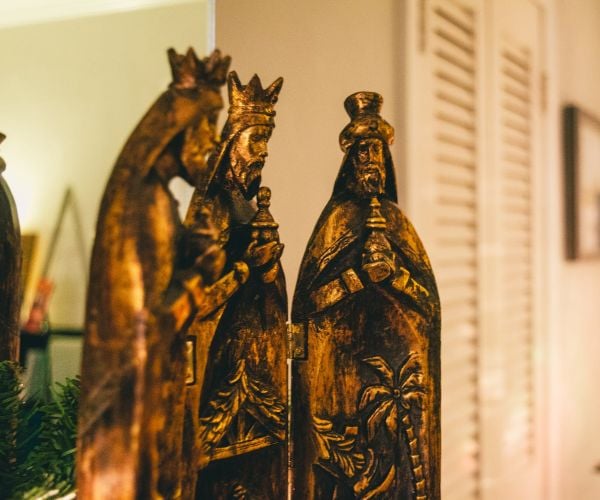 Whereas most places across the world will be winding down their Christmas spirits towards the end of December, Spain’s are still in full swing. Especially here in Barcelona, where you will continue to find exciting merry and bright markets, and admire the twinkling array of Christmas lights throughout the city.
Our blog will talk you through everything you need to know about the Day of the Three Kings in Spain, it’s history, how it’s celebrated, and key traditions involved so you can celebrate the Three Kings Day as well if you fancy.
History behind the Three Kings
The Three Kings come from the Bible, in the second chapter, verse 1-12 from the Gospel of St. Matthew, in which these ‘Magi’ followed a star all the way from the East to Bethlehem, the Kings in this sense represented the wise men. The wise men were not spoken of as Kings until the 3rd century, and they were renamed due to their wealth represented through their valuable gifts that they brought to baby Jesus; gold, frankincense and myrrh.
Whereas most places across the world will be winding down their Christmas spirits towards the end of December, Spain’s are still in full swing. Especially here in Barcelona, where you will continue to find exciting merry and bright markets, and admire the twinkling array of Christmas lights throughout the city.
Our blog will talk you through everything you need to know about the Day of the Three Kings in Spain, it’s history, how it’s celebrated, and key traditions involved so you can celebrate the Three Kings Day as well if you fancy.
History behind the Three Kings
The Three Kings come from the Bible, in the second chapter, verse 1-12 from the Gospel of St. Matthew, in which these ‘Magi’ followed a star all the way from the East to Bethlehem, the Kings in this sense represented the wise men. The wise men were not spoken of as Kings until the 3rd century, and they were renamed due to their wealth represented through their valuable gifts that they brought to baby Jesus; gold, frankincense and myrrh.
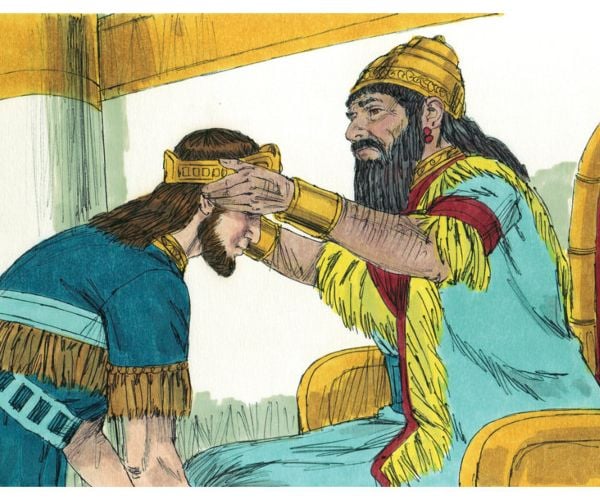 The Three Kings Day is now celebrated on the 6th of January and is also known as the Epiphany day, it is filled with festivities. In Spain these celebrations begin on the 5th of January, with each of the Kings arriving in the towns of Spain. In Barcelona the day of the Kings is an unmissable event, thought to be one of the biggest and most beautiful in Spain.
Letters to the Three Kings
It is tradition for children to write letters to the three kings; Melchior, Caspar and Balthazar, with their wishes and their achievements. These letters can then be given to the kings in person at the parade in Barcelona, soon to be explained…
The Three Kings Day is now celebrated on the 6th of January and is also known as the Epiphany day, it is filled with festivities. In Spain these celebrations begin on the 5th of January, with each of the Kings arriving in the towns of Spain. In Barcelona the day of the Kings is an unmissable event, thought to be one of the biggest and most beautiful in Spain.
Letters to the Three Kings
It is tradition for children to write letters to the three kings; Melchior, Caspar and Balthazar, with their wishes and their achievements. These letters can then be given to the kings in person at the parade in Barcelona, soon to be explained…
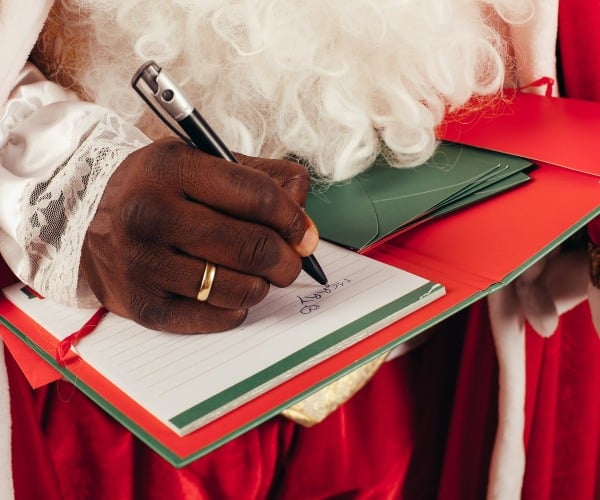 Celebrating the 5th of January
On the 5th of January most towns throughout Spain celebrate the arrival of the three kings with various magical festivities. In Barcelona they hold the Three Kings Parade, also known as La Cabalgata de los Reyes Magos.
Celebrating the 5th of January
On the 5th of January most towns throughout Spain celebrate the arrival of the three kings with various magical festivities. In Barcelona they hold the Three Kings Parade, also known as La Cabalgata de los Reyes Magos.
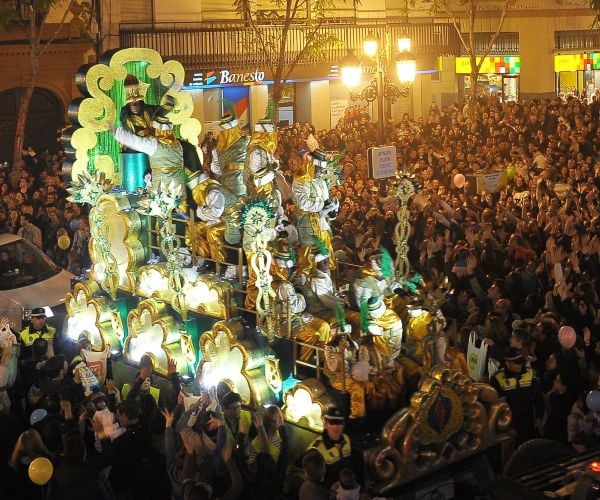 The arrival of the three kings usually takes place on a boat around 4pm, at Port Vell, in which they are greeted by the city’s Mayor. With the procession following:
In this parade you can find thousands of children and adults filling the streets in anticipation of the arrival of the three kings at 6pm on the Avenue del Marquès de l’Argentera. The three kings travel 5km around the city and finish their parade at the Magical Fountain of Montjuïc at around 9:30pm.
The parade is full of trucks, music, and dance, and uniquely decorated floats. There are three main floats which transport each of the kings and their helpers to throw sweet treats into the crowds as they pass through. They also give children the opportunity to give their wish lists to the king for the following day of gifts.
Traditions of the Three Kings Day
Following the parade, once families have returned home, children continue the excitement by leaving out food and water for the Kings and their camels. They also leave a pair of shoes or slippers out of their windows and doors so that the Kings can fill these with sweet treats and grant their wishes.
The arrival of the three kings usually takes place on a boat around 4pm, at Port Vell, in which they are greeted by the city’s Mayor. With the procession following:
In this parade you can find thousands of children and adults filling the streets in anticipation of the arrival of the three kings at 6pm on the Avenue del Marquès de l’Argentera. The three kings travel 5km around the city and finish their parade at the Magical Fountain of Montjuïc at around 9:30pm.
The parade is full of trucks, music, and dance, and uniquely decorated floats. There are three main floats which transport each of the kings and their helpers to throw sweet treats into the crowds as they pass through. They also give children the opportunity to give their wish lists to the king for the following day of gifts.
Traditions of the Three Kings Day
Following the parade, once families have returned home, children continue the excitement by leaving out food and water for the Kings and their camels. They also leave a pair of shoes or slippers out of their windows and doors so that the Kings can fill these with sweet treats and grant their wishes.
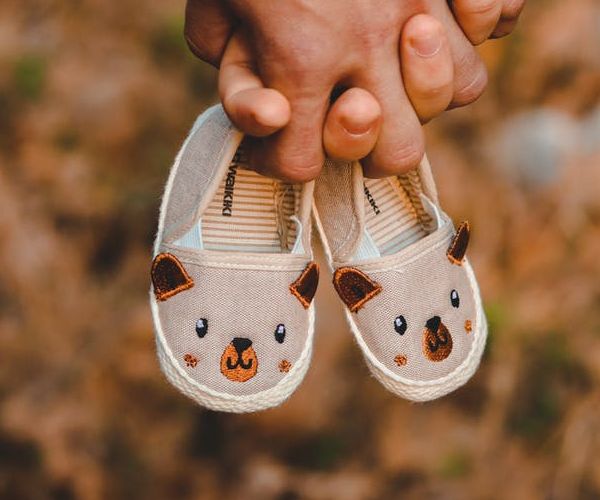 For children who may not have behaved so well, they will receive sweet coal, yet some children who behave well may also receive sweet coal to ensure they remain good in the new year. The coal actually comes from the legend of Carbonilla, the king who watches the children during the year to find out whether they have been good or bad, and the one who brings sweet coal.
Celebrations on the 6th of January
The day of the Kings is one for families to come together and enjoy a ‘feast for a king’. The most common and traditional treat you will find at your table is the dessert Roscón de Reyes. This dessert is a sweet bread cake and is filled with cream and topped with candied fruits, which are supposed to represent the jewels of the crown.
For children who may not have behaved so well, they will receive sweet coal, yet some children who behave well may also receive sweet coal to ensure they remain good in the new year. The coal actually comes from the legend of Carbonilla, the king who watches the children during the year to find out whether they have been good or bad, and the one who brings sweet coal.
Celebrations on the 6th of January
The day of the Kings is one for families to come together and enjoy a ‘feast for a king’. The most common and traditional treat you will find at your table is the dessert Roscón de Reyes. This dessert is a sweet bread cake and is filled with cream and topped with candied fruits, which are supposed to represent the jewels of the crown.
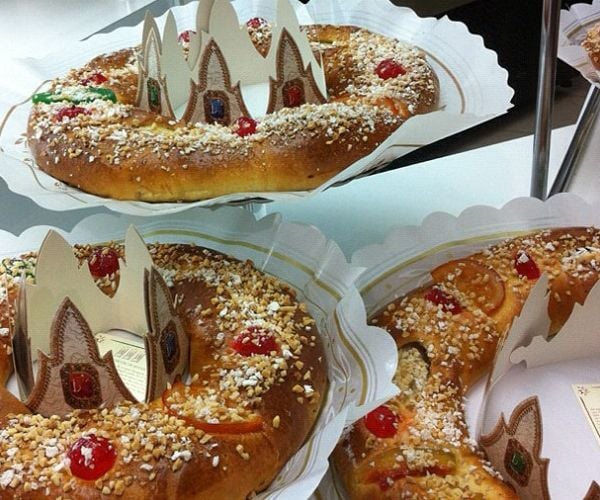 To make this even more exciting, the cake has two secret elements to it, primarily a dried fava bean, and a king figurine. Those who find the king are crowned king or queen for the day, and those who find the bean must pay for the dessert!
This special dessert can be found among many bakeries throughout Barcelona as well as restaurants who offer this during the day of the three kings.
Why not spread the Spanish Christmas spirit and keep your festivities going until the beginning of January, you could even try making your own Roscón de Reyes, here’s a festive recipe for you:
Roscón de Reyes Recipe
Ingredients
4 cups plain flour
½ teaspoon of salt
1 ounce dry bakers yeast
⅓ cup milk lukewarm
⅓ water lukewarm
6 tablespoons butter at room temperature
6 tablespoons sugar
Rind of 1 large orange grated
2 large eggs
1 tablespoon brandy or rum
1 egg white
2 cups assorted candied fruit chopped in different sizes
Step 1. Sift the flour and salt into a large mixing bowl, and make a well in the middle.
Step 2. In a smaller bowl, dissolve the yeast into the lukewarm milk and water. Once the yeast is completely dissolved, pour the mixture into the well of the flour.
Step 3. Scrape in just enough flour from around the well to create a thick batter, sprinkle some extra flour on top and cover with a kitchen towel. Leave for around 15 minutes.
Step 4. In a separate bowl use an electric beater to combine the butter and sugar until creamy.
Step 5. Once the dough is ready, add in the eggs, brandy, orange rind, and a splash of water to it. Mix well, until the dough is elastic and a bit sticky.
Step 6. Add the butter and sugar mixture into the dough and mix together
Step 7. Shape the dough into a ball and cover in oiled plastic wrap and a kitchen towel and leave somewhere warm. The dough should double in size over around 1-2 hours.
Step 8. Once the dough has doubled, punch down the dough on a lightly floured countertop or cutting board and knead the dough for two or three minutes.
Step 9. Roll it into a large rectangle and create a sausage shape by rolling the dough inwards. If you’re adding a bean and ceramic toy or king, do it now by poking it into the dough.
Step 10. Wrap the dough again and leave it in a warm place for around an hour to double in size.
Step 11. Preheat the oven to 180℃ and grease a large baking tray.
Step 12. Once the dough has risen, beat the remaining egg white and brush it across the top. Cover the cake in assorted dried fruits by pushing them gently onto the dough.
Step 13. Bake for 30 minutes until golden, cool on the rack and enjoy!
Sandra Roig is Marketing Director at AB Apartment Barcelona. AB Apartment Barcelona is an apartment rental agency offering over one thousand short and long term apartments across Barcelona.
If you would like to be a guest blogger on A Luxury Travel Blog in order to raise your profile, please contact us.
To make this even more exciting, the cake has two secret elements to it, primarily a dried fava bean, and a king figurine. Those who find the king are crowned king or queen for the day, and those who find the bean must pay for the dessert!
This special dessert can be found among many bakeries throughout Barcelona as well as restaurants who offer this during the day of the three kings.
Why not spread the Spanish Christmas spirit and keep your festivities going until the beginning of January, you could even try making your own Roscón de Reyes, here’s a festive recipe for you:
Roscón de Reyes Recipe
Ingredients
4 cups plain flour
½ teaspoon of salt
1 ounce dry bakers yeast
⅓ cup milk lukewarm
⅓ water lukewarm
6 tablespoons butter at room temperature
6 tablespoons sugar
Rind of 1 large orange grated
2 large eggs
1 tablespoon brandy or rum
1 egg white
2 cups assorted candied fruit chopped in different sizes
Step 1. Sift the flour and salt into a large mixing bowl, and make a well in the middle.
Step 2. In a smaller bowl, dissolve the yeast into the lukewarm milk and water. Once the yeast is completely dissolved, pour the mixture into the well of the flour.
Step 3. Scrape in just enough flour from around the well to create a thick batter, sprinkle some extra flour on top and cover with a kitchen towel. Leave for around 15 minutes.
Step 4. In a separate bowl use an electric beater to combine the butter and sugar until creamy.
Step 5. Once the dough is ready, add in the eggs, brandy, orange rind, and a splash of water to it. Mix well, until the dough is elastic and a bit sticky.
Step 6. Add the butter and sugar mixture into the dough and mix together
Step 7. Shape the dough into a ball and cover in oiled plastic wrap and a kitchen towel and leave somewhere warm. The dough should double in size over around 1-2 hours.
Step 8. Once the dough has doubled, punch down the dough on a lightly floured countertop or cutting board and knead the dough for two or three minutes.
Step 9. Roll it into a large rectangle and create a sausage shape by rolling the dough inwards. If you’re adding a bean and ceramic toy or king, do it now by poking it into the dough.
Step 10. Wrap the dough again and leave it in a warm place for around an hour to double in size.
Step 11. Preheat the oven to 180℃ and grease a large baking tray.
Step 12. Once the dough has risen, beat the remaining egg white and brush it across the top. Cover the cake in assorted dried fruits by pushing them gently onto the dough.
Step 13. Bake for 30 minutes until golden, cool on the rack and enjoy!
Sandra Roig is Marketing Director at AB Apartment Barcelona. AB Apartment Barcelona is an apartment rental agency offering over one thousand short and long term apartments across Barcelona.
If you would like to be a guest blogger on A Luxury Travel Blog in order to raise your profile, please contact us.Did you enjoy this article?
Receive similar content direct to your inbox.



Spanish children certainly know where they stand if they are given sweet coal! Encouraging that they are putting the emphasis on good behaviour.
Haha thank you for your comment Valerie! Isn’t it a funny tradition.
Full marks to Barcelona for keeping traditions going. Long may the practice of children hand-writing letters continue.
We agree! If you’ve not experienced a winter in Barcelona you must, you’ll be able to see these traditions throughout all the Christmas markets, it’s incredible they still keep them going.
Let’s hope that omicron tends out to be nothing much more than the sniffles and that Barcelona can enjoy its usual celebrations. We are all in need of a dose of normality.
Thanks for your comment Sheila. We agree. Fingers crossed normality returns “pronto”!